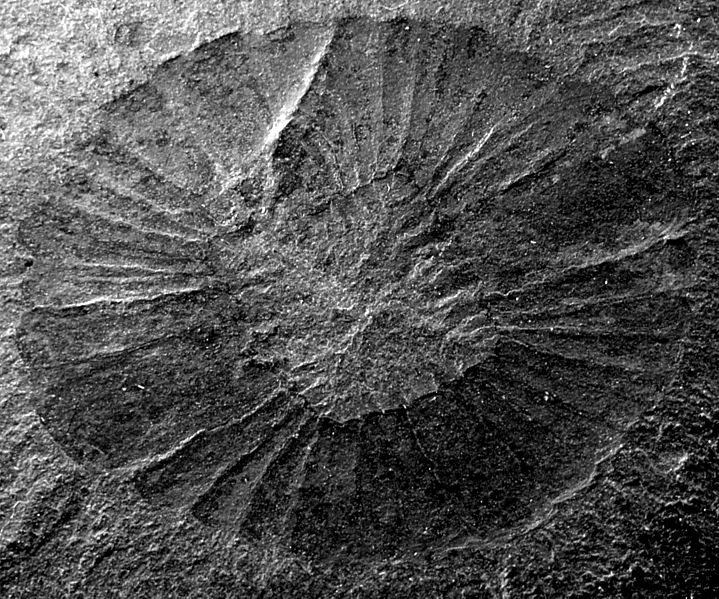Image: Anomalocaris canadensis mouthpiece, Burgess Shale

Description: Anomalocaris canadensis Whiteaves, 1892 mouthpiece (~5.25 x ~4.25 cm), preserved as a carbonized film in slightly metamorphosed shale from the Middle Cambrian-aged Burgess Shale of southwestern Canada (YPM 5825, Yale University’s Peabody Museum, New Haven, Connecticut, USA). This fossil was formerly identified as “Peytoia nathorsti”, a fossil jellyfish (Animalia, Cnidaria, Scyphaozoa The Middle Cambrian-aged Burgess Shale is the most famous fossil deposit on Earth. It is located near the town of Field in Yoho National Park, southeastern British Columbia, western Canada. The deposit is famous for its spectacular soft-bodied preservation - the organisms have had their appendages & internal organs preserved. Many tens of thousands of fossils have been collected from the Burgess Shale Formation over the last century. Including known, but unnamed species, and excluding known or demonstrable junior synonyms, the Burgess Shale biota totals at least ~280 species. Many claim that Charles Walcott discovered the Burgess Shale Lagerstätte (as soft-bodied fossil deposits are called by paleontologists) in 1909. However, it was actually discovered in 1886 or 1888 by Richard McConnell, based on anomalocarid appendage material from Mt. Stephen, in the Campsite Cliff Member of the Burgess Shale Formation. The main collecting localities have been two quarries (Walcott Quarry & Raymond Quarry) on the western side of the ridge connecting Mt. Field and Wapta Mountain a little north-northeast of Field. Numerous other smaller localities have been identified in the same area & for many, many kilometers to the south. Collecting at the Burgess Shale was most intense in 1910-1917 (Charles Walcott), 1925-1930 (Harvard’s Museum of Comparative Zoology), 1966-1967 (Geological Survey of Canada), and 1975-2000s (Royal Ontario Museum). Some of the most celebrated problematic fossil organisms from the Burgess Shale are the anomalocarids, the namesake of which is Anomalocaris canadensis Whiteaves, 1892. The genus name “Anomalocaris” means “strange shrimp”, which is ironically appropriate, because the name was given to fossil remains identified as shrimp bodies. But, anomalocarids are anything but shrimp. These creatures had medium-sized to large bodies (extrapolated up to ~3 meters long) with a head having a pair of grasping claws & short-stalked eyes & a pineapple ring-shaped mouth, plus a body with two lateral rows of swimming flaps. The first anomalocarid fossils (isolated grasping claws) were discovered in the 1880s from British Columbia’s Burgess Shale Formation. They were identified as shrimp bodies lacking heads (see photo elsewhere in this album). In general, paleontologists didn’t recognize that these Anomalocaris fossils represented parts of a much larger organism. The true nature of the complete Anomalocaris organism wasn’t realized until very rare complete specimens were excavated from Burgess Shale quarries by the Royal Ontario Museum. The mouthpiece of Anomalocaris canadensis turned out to be an already-known fossil previously identified as a jellyfish - Peytoia nathorsti (see this photo). Anomalocaris mouthpieces resemble pineapple rings, consisting of a radially arranged series of plates with inward-directed spines. Some bitemarks found on trilobites & other fossil arthropods are consistent with anomalocarid mouthpiece morphology. The unusual body plan of anomalocarids does not fit into any traditional arthropod group, so new high-level taxa have been created to accomodate it (see Collins, 1996, Journal of Paleontology 70: 280-293). Classification: Arthropoda, Dinocarida, Radiodonta, Anomalocaridae Stratigraphy: Walcott Quarry Member, Burgess Shale Formation, Ptychagnostus praecurrens Interval-zone, lower Marjuman Stage, middle Middle Cambrian. Locality: Walcott Quarry, western side of ridge between Mt. Field & Wapta Mountain, north-northeast of the town of Field, southeastern British Columbia, southwestern Canada.
Title: Anomalocaris canadensis mouthpiece, Burgess Shale
Credit: Anomalocaris canadensis mouthpiece (Burgess Shale Formation, Middle Cambrian; Walcott Quarry, above Field, British Columbia, Canada)
Author: James St. John
Usage Terms: Creative Commons Attribution 2.0
License: CC BY 2.0
License Link: http://creativecommons.org/licenses/by/2.0
Attribution Required?: Yes
Image usage
The following image is a duplicate of this image (more details):
There are no pages that link to this image.

